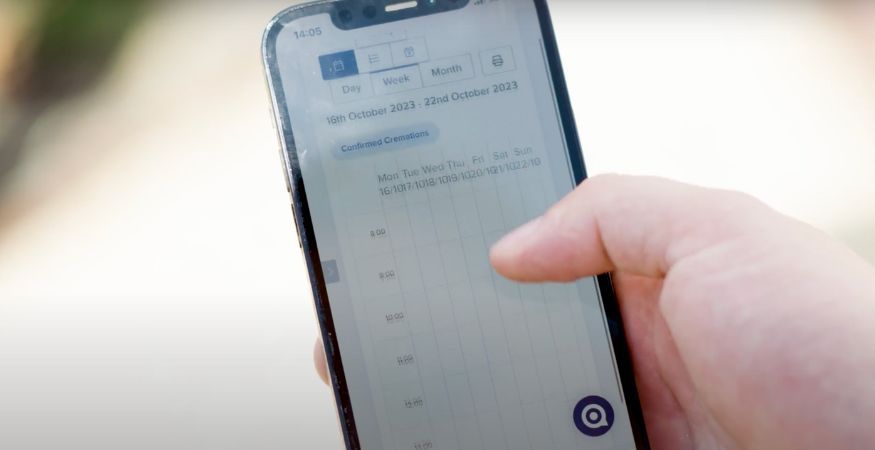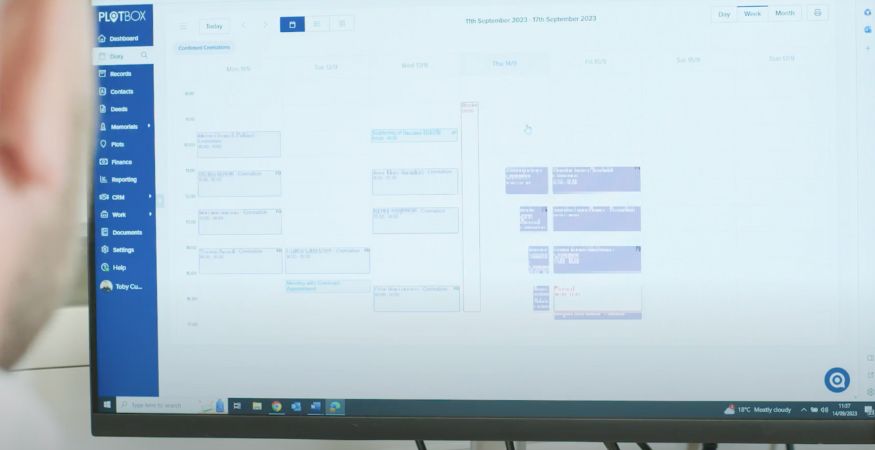| Read time: 7 mins
When we talk about intuitive cemetery software, what we’re really talking about is how easy it is to use.
What it also means is how it can make life easier for you.
For example, can a member of your back office team sit down and intuitively know how to use it?
Does it have a clear layout? Are things in a logical place, and in a logical order? Is it easy to understand? Easy to navigate? Does it have a user-friendly interface? Is it configurable? Does it have personalised dashboards? Is there little switching between tabs or screens for related tasks? Can I access it remotely? Can I enter data just once? Can I retrieve that data easily?
In short, is it easy to do what I need it to do?
If the answer to those questions is yes, and with some small amount of modesty, you have just described a cemetery management solution like PlotBox.
And why are we telling you this?
All of that doesn’t happen by accident, it's by design - user-centric design, to be slightly technical for a moment - and that’s important because it demonstrates a clear understanding of who you are and what your business and operational needs are.
A solution that’s easy to use is designed to make your role easier - it connects every element of your operation, and rationalises disjointed, unnecessary steps and processes.
The Why
First, let’s state the obvious. Paper processes are inefficient.
We could fill a dozen blogs with the why of it all, but in essence, it's because they don’t have the accessibility and interconnectedness that a digital, cloud-based solution provides.
Or to put another way - they’re not easy to use.
So with time being such a precious commodity, why do organisations still hold on to them?
That could be for a number of reasons: a familiarity with traditional methods, a fear of disruption, a lack of information, cost - of course, and perception of digital solutions being complicated to use and requiring a high level of technical expertise.
But here’s the point - just because something does something brilliantly and in a different way, it doesn’t mean that it’s complicated.
And at this point, we can switch neatly from asking ‘Why’, to asking, ‘Why not?’.
The old dictum of ‘that’s the way we’ve always done it’ is not only outdated, but is costing organisations time and money.
Now, let’s get to some specific examples from PlotBox.
An intuitive interface
An intuitive interface means everything is where it should be: a home screen that is easy to navigate, with clear menus - from the diary to records, plots, contracts etc., all making it easier for staff to find what they’re looking for.
As one customer told us, “With PlotBox, from the outset, it was very sleek - from the dashboard to the different tabs that we use, everything was very straightforward, you could look at it and it was very logical.”
From a design perspective, less time is spent going in and out of different systems, or poring through paper records to find what you’re looking for.
This will be a recurring theme.
Customisable Dashboard
PlotBox provides staff with the ability to customise their own dashboards. That means when they log in, they can quickly and easily get to information related to their specific job roles.
This provides the flexibility to personalise the solution to their own preferences, with quicker access to frequently used features and data.
And who doesn't want to be more flexible?
Scheduling
The PlotBox scheduling feature allows staff to have a clear overview of all the events taking place within the facility via shared, customisable, and colour-coded calendars that are updated in real time.
This allows teams to plan their time in advance in a much more efficient way - every member of staff can look to see what’s on that day, week or month, allowing them to plan different appointments or resources around those dates and times.
That not only avoids double-bookings and improves communication across teams and facilities, but ensures that staff are always in the right place at the right time.
And all from a simple, yet very effective shared calendar view.

Workflows
We talk a lot about workflows in relation to cemetery operations, for the simple reason that they underpin many of the processes and steps required to get work done.
Think of them literally as work flowing from one stage to the next - whether that’s through a colleague, tool, or another process.
In this way, your workflows are a way of simplifying and refining your processes, reducing the number of manual steps, and in turn, creating efficiencies while reducing the risk of errors.
Which is a win all round.
Learn more about workflows and risk assessments here.
Within PlotBox, for example, workflows can be built into the burial process itself.
When booking a burial, the details of a related work order can be pre-set - eg. the work type, assignation to, due date etc. and linked to the event. In doing this, and going back to what we talked about earlier, the user can remain within burial booking to do all of that.
No coming in and out of screens.
Cemetery mapping and plot management
Speaking of maps, integrating digital maps with software completely changed the game when we first introduced it to the deathtech space.
In fact, we’ve built our entire technology around this locational piece, to both provide the most accurate maps available, as well as a range of inventory-related benefits.
Accurately attaching data to a true location makes it much easier to understand and audit the physical locations in relation to your business systems. In practical terms, that can mean finding inventory you didn’t know you had, or finding risk you didn’t know was there - such as mis-sold or double sold plots.
Clicking on any plot within a colour-coded digital map will instantly bring up all related information, including its status - whether it's available for sale or not, its owner, and a range of other information.
Again, all this intuitively linked will provide much easier, and more efficient ways of managing your inventory - and all with a few simple clicks.
In nutshell, it helps you to make better decisions, quicker.
Data retrieval
Data retrieval - or getting the information you need - is perhaps one of the most basic tenets of an intuitive software solution.
The efficiency with which you can manage your records will in no small way save you and your staff time, allowing them to focus on providing excellent customer service by providing answers more quickly.
A query such as, “Where and when was my great grandfather buried, and are there any plots available nearby”, can be answered in an instant; and also having that kind of information available remotely opens up a whole range of benefits - not only to back office staff, but to sales teams.
That’s why a good cemetery software solution will have search functionality, that, combined with filters, and drop down menus can help you sort and retrieve information across large sets of data.
And that is made possible by having all of your data in one place - data that only needs to be entered one time.
Checklists
Checklists are a vital way of ensuring that tasks are carried out in the right way at the right time, using all of the required [correct] information.
In terms of simplification, they are a very good way of standardising procedures, assuring compliance, and providing a clear roadmap of what tasks need to be completed - reducing the likelihood of duplication, or important steps being overlooked.
From daily maintenance tasks to grave management, their value can’t be overstated.
Intuitive solutions such as PlotBox are those that provide easily configurable checklists for specific tasks or workflows.
For example, from a burial booking, one might create mandatory fields relating to actions that must be carried out - confirming dimensions or removing surrounding risk - or indeed, the uploading of certain scanned documents - all of which provides a clear audit trail for you of who did what and when.
Easy, not simple.
The list could go on, and we could point to other ways in which an intuitive, easy to use system like PlotBox can improve daily operations, for example, by providing remote access to data, or portals that provide funeral directors with 24/7 visibility of your calendars.
But we’ll leave that for next time.
This time, we’ll leave you with this thought: when it comes to older systems and processes vs a new digital solution - just because something is simple, doesn’t mean it’s easy to use, and just because something is easy to use, doesn't mean it’s simple.
What an easy to use software solution like PlotBox will give you is: time, increased productivity and cost savings, better customer service, increased user adoption, and less risks.
Discover why digital transformation is a must have for your deathcare operation. Download the eBook:

